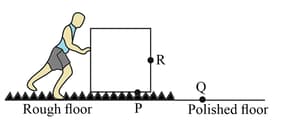Anil Ahlawat Solutions for Chapter: Friction, Exercise 1: EXERCISES
Anil Ahlawat Science Solutions for Exercise - Anil Ahlawat Solutions for Chapter: Friction, Exercise 1: EXERCISES
Attempt the practice questions on Chapter 11: Friction, Exercise 1: EXERCISES with hints and solutions to strengthen your understanding. NSO Science Olympiad Workbook Grade 8 solutions are prepared by Experienced Embibe Experts.
Questions from Anil Ahlawat Solutions for Chapter: Friction, Exercise 1: EXERCISES with Hints & Solutions
Read the given statements and select the correct option.
Statement : It takes a much longer time and covers more distance to stop a moving ship in water than a moving car with the same speed on the road.
Statement : The friction on the water surface is much less than the solid surface.
Ram pushes the box by applying a force of in horizontal direction so that the box starts sliding along the floor as shown in the figure. Find the point where the frictional force acting on the box is maximum.

A man sharpens his knife as shown in the figure. Which of the following properties of friction are in use?

(i) Friction helps us to hold objects.
(ii) Friction acts in the opposite direction of motion.
(iii) Friction causes the surfaces in contact to wear away.
(iv) Friction produces heat energy.
John carried out an experiment to find out how different surfaces affect the distance a car travelling at needed to stop once the brakes are applied. The results are shown below:
| Type of road surfaces | ||||
| Stopping distance |
Which type of road will provide the most friction for the car to stop?
When a bicycle is in motion, the force of friction exerted by the ground on the two wheels is such that it acts _____.
When friction is acting in the direction of , in which direction do you think the force is applied?

Consider a vehicle going on a horizontal road towards east. Neglect any force due to air. The frictional force on the vehicle by the road _____.
A box is given a push across the floor. It comes to stop shortly after. Which one of the following reasons explains why this happens?
